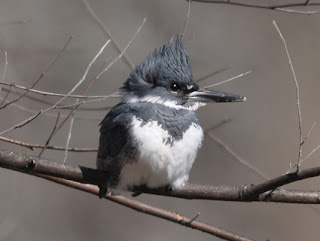Most of my posts are about places I've been and birds I've seen. I write about birding basics, where to find birds and how to identify them. So, for this post I decided to do something a bit different. I will keep it along the same traditions...a birding tip, where I was and birds I saw...but this is going to be more of a storytelling and reflection piece.
Today I abandoned my plans to go birding at Bolinas Lagoon. Bolinas Lagoon is rumored to be one of the best birding places in this part of California, so naturally I was attracted. However, the low lying fog today made me think twice. Not to worry, I will make it out to Bolinas on a clear, warm day soon and I'm sure it'll be amazing! In the meantime, the sun was out in San Francisco and the air was still, so I decided to take a short walk to Thompson's Reach in the Tennessee Hollow watershed, near my apartment. Last time I walked this trail, I discovered a somewhat secluded bench, surrounded by shrubs and trees and relatively out of sight. That is where I went today.
| Thompson's Reach in the Tennessee Hollow watershed, photo from presidio.gov |
 |
| Yellow-rumped warbler, photo by Lyn Topinka |
There is something to be said about just sitting, listening and watching. It provides you with a connection to nature and wildlife that I believe to be incredibly important for our health, mental and physical. Despite my calm state of reverie, I did get excited and quickly reach for my binoculars when I saw a bird. I still have that desire to identify birds and know what I saw. Out of the corner of my eye I saw a spotted towhee. I only saw him briefly but in that short moment I could have sworn he looked me right in the eye. His striking red iris gave me goosebumps.
The peaceful chorus of bird chirps was suddenly interrupted, all the birds in the redwood trees scattered, screaming in panic. At least twenty yellow-rumps and five northern flickers, which I hadn't even seen before, fled. I knew a predator had just arrived. It was a thrilling sight in my moment of peace and relaxation. Only seconds after the tiny birds fled the cover of the redwood trees, a hawk appeared in the sky. I raised my binoculars and focused in on the small hawk. It had distinct stripes on the tail, a light colored belly and light colored wings, with black stripes on the feathers. There was also some streaking on the chest. I knew instantly it was a sharp-shinned hawk because of the square tail. The other hawk that it can be easily confused with is the cooper's hawk, which is a similar size and has very similar markings, however, the cooper's hawk tail is rounded. This hawk was a juvenile, because it lacked the rufous colored chest. I watched as the hawk circled a few times over the Hollow and then left.
 |
| Juvenile sharp-shinned hawk, photo by Kelly Wohlwend |
Before leaving my favorite place, I decided to walk over to the edge of the trail and look out over Thompson's Reach one last time. I skimmed the area with my binoculars, just in case anything else wanted to surprise me. What I saw was something rather comical. A male anna's hummingbird, a common sight here in the Presidio, was performing a rather amusing courtship ritual. It was either courtship or territorial, but either way it made me laugh. He did perform, just once that I saw, a typical courtship maneuver; flying straight up into the sky and then diving down toward the ground. But this isn't what I found humorous. He would sit on the end of a willow sprig and sing his raspy song, his body flat against the branch, in a completely horizontal position. After one vocalization he would fly to a second bush, this time a lupine. He flattened his body out again and vocalized. After the lupine he moved to his final shrub, another willow, sat the very top of a sprig, laid out flat and sang. He did this over and over, moving from these same three bushes, in the same rotation. Every once and a while the sun would illuminate his shimmering, scale like feathers on his head causing them to glow a brilliant fuschia.
Leaving the hummingbird to his antics, I left the Hollow. I cannot end my post without listing off the bird species I saw, or at least was able to identify. I didn't spent every moment with my eyes behind my binoculars and I didn't carry along my field guide, so a few species did elude me. Here is a list of what I could say with certainty I saw today: red and yellow-shafted northern flicker, yellow-rumped warbler, anna's hummingbird, spotted towhee, sharp-shinned hawk, white-crowned sparrow, song sparrow, European starling. I saw another bird, only for a moment, the size of a sparrow with very distinct streaking like a fox sparrow but it was holding its tail upright like a wren and bobbing it. This bird will have to remain a mystery...for now.



















